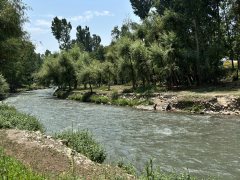Hugam, Indian-administered Kashmir – Nasir Amin Bhat, 17, was barely ankle-deep in the water when his school friend and neighbour Adil Ahmad shouted from the riverbank on a breezy summer evening in May.
“Turn back! There’s something in the water.”
Across the Lidder, a tributary of the Jhelum River, in Hugam village of Indian-administered Kashmir’s Anantnag district, a Eurasian otter (Lutra lutra) plunged into the glacial waters and started paddling furiously against the current with all four limbs.
“I had no idea what it was,” Bhat, a high school student, told Al Jazeera, “but I grabbed my smartphone and turned on the camera.”
The grainy, nine-second video shows the creature with a fur coat – classified as “near threatened” on the International Union for Conservation of Nature (IUCN) Red List – gliding out of the water and jumping onto the riverbank.
After a few clumsy steps, the semiaquatic animal, which can reach elevations of 3,660 metres (12,000 feet) in the Himalayas during the summer, disappears behind a thick grove of bushes, bringing the video to an uneventful end.

Long believed to have gone extinct, Eurasian otters seem to be showing signs of resurgence in Kashmir, with three individuals spotted by Indian wildlife officers in two places since 2023.
The chance sightings have excited environmentalists and wildlife conservationists while raising hopes of a better future for the Himalayan region’s fragile freshwater ecosystems, which have been battered by climate change in recent years.
‘Habitat has improved’
Indian wildlife biologist Nisarg Prakash believes the sighting of otters in Kashmir was an indicator of high-quality aquatic habitats.
“The reappearance of otters might mean that poaching has come down or the habitat has improved, and maybe both in some cases,” Prakash, whose work focuses on otters in southern parts of India, told Al Jazeera.
Protected under India’s Wildlife Protection Act, otters were once widely distributed across north India, including the Himalayan foothills, the Gangetic plains and parts of the northeast.
A peer-reviewed study by IUCN in November last year noted that the Eurasian otter, known among Kashmiri locals as “voddur”, was found in water bodies of Lidder and Jehlum valleys, including Wular Lake, one of Asia’s largest freshwater lakes.

However, over the years, their population became “patchy and fragmented due to habitat loss, pollution and human disturbances”, says Khursheed Ahmad, a senior wildlife scientist at the Sher-e-Kashmir University of Agricultural Sciences and Technology (SKUAST-K).
Ahmad said that, due to habitat alterations from human activities and the encroachment of their ideal habitats along riverbanks and other water bodies, Eurasian otters retreated and became confined to areas that were least accessible to humans.
“Although they were not extinct, sightings and occurrences had become extremely rare and they were never documented,” said Ahmad, who heads the Division of Wildlife Sciences at SKUAST-K.
Less than two years ago, a research team led by Ahmad accidentally stumbled on otters during a study on musk deer in Gurez, a valley of lush meadows and towering peaks split into two by the Kishanganga River along the Line of Control, the de facto border between India and Pakistan in the Himalayas.
Past midnight on August 6, 2023, two individual otters were captured





